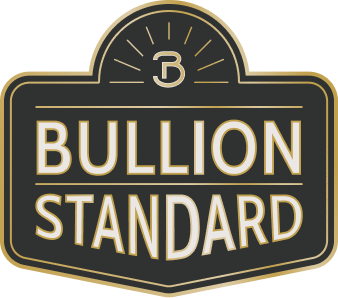Why Gold Jewelry Shouldn’t Be Your Primary Investment
By Bullion Standard ·
6 min read
Is gold jewelry a good investment? Generally speaking, it can be—but it wouldn't be ideal as your main investment path.
Although gold jewelry can be an appealing way to own precious metal, it often comes with additional costs and lower resale value. Unlike gold bullion, jewelry’s value can be tied to trends and craftsmanship rather than its gold content alone.
At Bullion Standard, we pride ourselves on being leaders in the precious metal industry. We strive to guide investors in making educated decisions by focusing on stability and long-term gains.
In this blog post, we’ll explain why gold jewelry should be a secondary asset in your portfolio and share alternative options to consider.
Why Investors Are Drawn to Gold Jewelry
Gold jewelry often attracts investors because it’s something they can physically hold and appreciate. It’s also a popular choice for marking special occasions or giving as meaningful gifts, adding an emotional connection that can’t be matched by other assets.
This combination of beauty, cultural significance, and sentimental value makes gold jewelry appealing. However, while it offers some of these advantages, it doesn’t always translate into financial returns.
For this reason, investors should carefully consider the difference between sentimental and investment value.
 Is Gold Jewelry a Good Investment? Understanding the Limitations
Is Gold Jewelry a Good Investment? Understanding the Limitations
1. High Markups and Lower Resale Value
Gold jewelry often comes with substantial markups that reflect the design, craftsmanship, and brand reputation. Jewelers also incorporate other costs, such as marketing, packaging, and operational expenses, which raise the price beyond the actual gold content.
Consequently, if you decide to sell your jewelry, you may only recoup a small percentage of what you originally paid, reducing its financial benefit as an investment.
2. Purity and Quality Concerns
Unlike gold bullion and other precious metals, which are typically refined to high purity levels, most gold jewelry contains alloys that strengthen it for everyday wear. Jewelers commonly mix gold with metals like copper, nickel, or silver, which reduces the gold’s overall purity.
When it comes time to sell, the lower purity can negatively impact the jewelry’s value compared to purer gold forms like bars or coins, resulting in a significant difference in resale prices.
3. Depreciation and Trends
Gold jewelry tends to lose value over time, mainly due to shifting fashion trends and personal tastes. Its worth isn’t solely determined by the amount of gold it contains but also by its design and brand appeal.
Since these factors can change with consumer preferences, it can be challenging to find buyers willing to pay full value. This often results in delays when selling or the need to lower the price to attract interest.
The Advantages of Gold Bullion in an Investment Portfolio
Gold bullion, whether in the form of gold bars or gold coins, offers several advantages for investors seeking stability and value. One key benefit is its higher purity level compared to jewelry. This high purity means that bullion’s value closely mirrors the market price of gold, providing a clear and accurate reflection of its worth.
Additionally, purchasing bullion often involves lower premiums. Bullion dealers have fewer added costs compared to jewelers, as there are no charges for intricate designs or brand value. As a result, you’re paying primarily for the gold itself, rather than additional markups.
Gold bullion is also easier to sell due to its standardization in weight and purity. Unlike jewelry, which often requires an appraisal to determine its worth, gold bars and coins come with a clear, standardized valuation. This ensures you can quickly liquidate and sell your gold holdings when needed.
Diversifying Your Gold Investments
To strengthen your portfolio, it’s wise to diversify your gold investments. Here are some options to consider beyond bullion:
- Gold ETFs and Mutual Funds: Gold exchange-traded funds (ETFs) and mutual funds allow investors to own shares in gold without physically storing it. These funds track gold’s market price, making it a convenient way to gain exposure to gold’s value.
- Mining Stocks: Investing in gold mining stocks offers a way to profit from pure gold indirectly. When gold prices rise, mining companies often benefit. However, this option comes with its own risks tied to the mining industry.
- Digital Gold: Digital gold investments allow you to purchase and sell gold electronically. This eliminates the need for physical storage and provides an easy way to diversify without logistical concerns.
 The Role of Gold Jewelry in a Balanced Portfolio
The Role of Gold Jewelry in a Balanced Portfolio
While gold jewelry shouldn’t be your primary investment, it can still play a role in your portfolio. Consider these points when investing in gold jewelry:
Buy What You Love
If you’re buying gold jewelry, choose pieces that genuinely resonate with you or have personal significance. Treat them as luxury items rather than financial assets.
This mindset helps you enjoy the best parts of the jewelry without relying on it to generate substantial financial returns over time. Then, if the value appreciates, it becomes an added bonus.
Focus on Quality
If you decide to include jewelry as a small part of your investment strategy, prioritize high-quality pieces that offer higher purity levels. Look for fine jewelry made with 18-karat or 22-karat gold to retain better value over time.
It’s also essential to buy from trusted jewelers who provide authenticity certificates, so you have verifiable proof of the gold’s quality.
Consider Heirloom Potential
Gold jewelry often holds sentimental importance and can serve as a treasured heirloom that’s passed down within families. Choosing classic, durable pieces ensures that the jewelry remains in great shape and keeps its value on a personal level.
Although it may not be the most lucrative investment, well-preserved jewelry can help build a legacy of memories and connections that last for generations.
Conclusion: Balancing Sentiment and Strategy
Gold jewelry can be an attractive addition to your collection, but it shouldn’t be your main investment. The high markups, depreciation risks, and varying purity make it a less reliable financial asset. Instead, consider focusing on gold bullion for a stable, lower-risk investment that retains its value over time.
So, is gold jewelry a good investment? It certainly can be, but that is not always the case. So if you choose to invest in gold or silver jewelry, approach it with a passion for the pieces, understanding that they may hold personal rather than financial value.
At Bullion Standard, we’re here to guide you in making the right gold investments. Our mission is to empower you to take the reins of your financial future. If you’re interested in learning more about gold investments, visit our website for educational resources or contact us for expert advice.



 Is Gold Jewelry a Good Investment? Understanding the Limitations
Is Gold Jewelry a Good Investment? Understanding the Limitations The Role of Gold Jewelry in a Balanced Portfolio
The Role of Gold Jewelry in a Balanced Portfolio
















